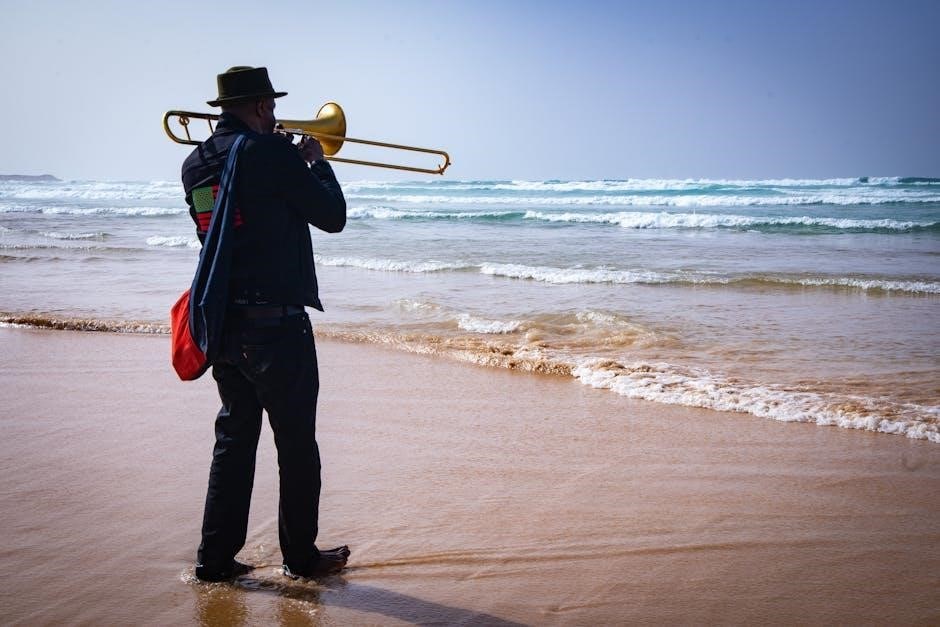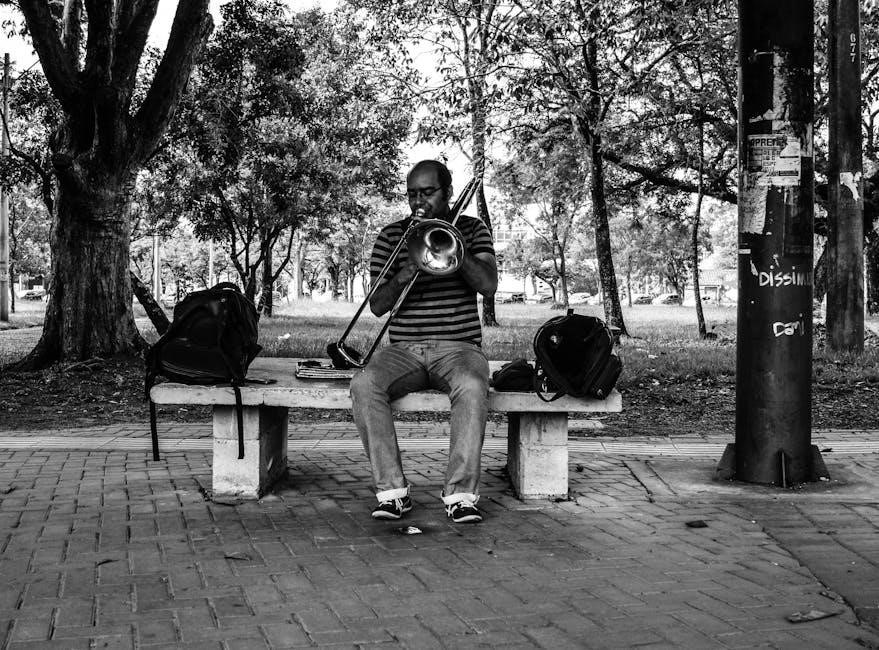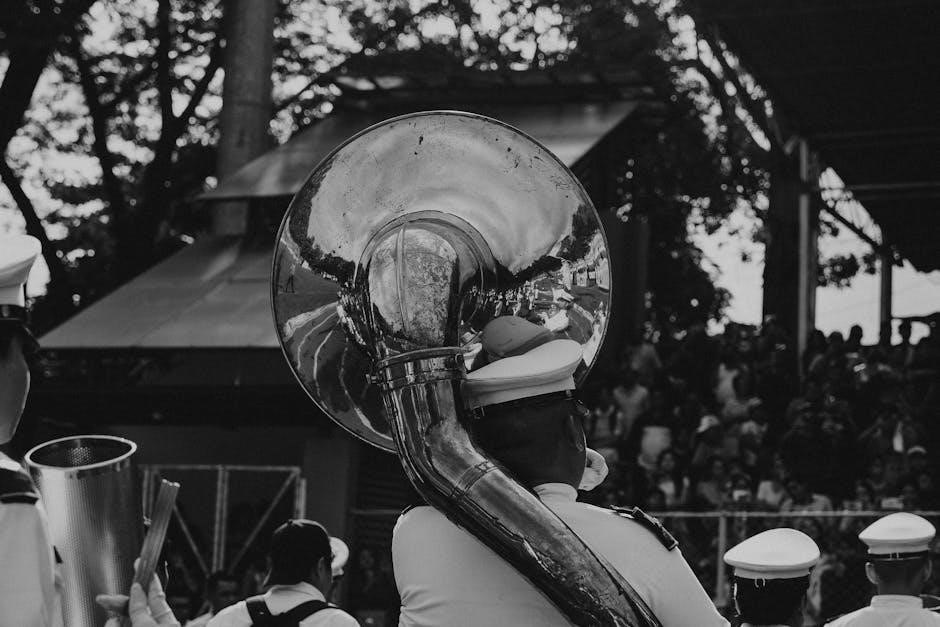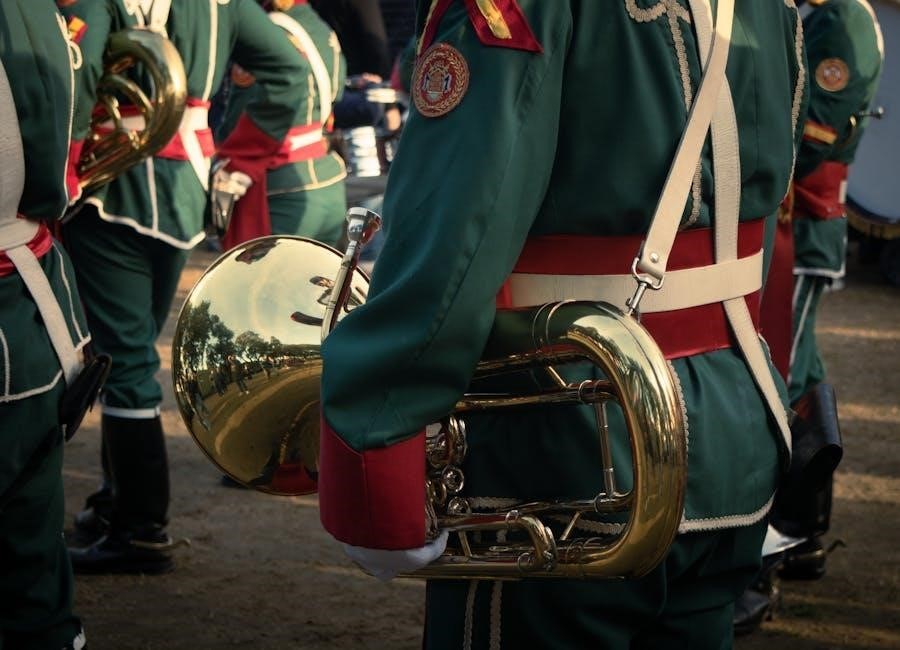Morceau Symphonique, composed by Alexandre Guilmant, is a renowned solo trombone piece with piano accompaniment. Its lyrical and technical elements make it a cornerstone of trombone repertoire, ideal for showcasing both expressive and virtuosic skills. Available as PDF sheet music, it remains a popular choice for performers and educators alike.

Historical Background
Morceau Symphonique, composed by Alexandre Guilmant, is a cornerstone of trombone repertoire, blending lyrical and technical elements. Its historical significance lies in its role as a solo trombone piece with piano accompaniment, widely performed and admired.
2.1 Composer Alexandre Guilmant
Alexandre Guilmant, a French composer and organist, is renowned for his contributions to classical music, particularly in the realm of organ and trombone repertoire. Born in 1837, Guilmant was a prominent figure in the Romantic era, known for his mastery of instrumental composition. His works often blend lyrical melodies with technical challenges, making them both expressive and demanding for performers. Guilmant’s Morceau Symphonique, composed for solo trombone with piano accompaniment, is a testament to his ability to craft pieces that highlight the trombone’s unique tonal qualities. This piece has become a staple in trombone literature, celebrated for its balance of elegance and virtuosity. Guilmant’s legacy extends beyond Morceau Symphonique, as his compositions continue to inspire musicians and educators worldwide. His work remains widely available in sheet music formats, including PDF, ensuring its accessibility to modern performers and enthusiasts.

2.2 Historical Significance
Morceau Symphonique holds a prominent place in the history of trombone literature, serving as a landmark piece that elevated the instrument’s role in classical music. Composed in the late Romantic era, it reflects the evolving recognition of the trombone as a solo instrument capable of expressive and technical brilliance. Guilmant’s work was among the first major compositions written specifically for trombone, paving the way for future generations of composers and performers. The piece’s availability as PDF sheet music has ensured its accessibility, making it a favorite among trombonists and educators. Its historical significance lies in its ability to bridge the gap between orchestral and solo repertoire, showcasing the trombone’s versatility. Today, Morceau Symphonique remains a cornerstone of trombone education and performance, highlighting its enduring influence on the instrument’s development. Its technical and expressive challenges continue to inspire musicians, solidifying its place in musical history.

Composition and Structure
Morceau Symphonique, composed by Alexandre Guilmant, is a solo trombone piece with piano accompaniment. Its structure balances lyrical melodies and technical demands, showcasing the trombone’s expressive and virtuosic capabilities in a symphonic context.
3.1 Musical Elements
The Morceau Symphonique for trombone and piano, composed by Alexandre Guilmant, is a rich and expressive work that showcases a blend of Romantic-era musical elements. The piece is written in the key of E-flat major, with a lyrical and soaring melody that highlights the trombone’s ability to produce both legato and virtuosic passages. It features a sonata-like structure, with a clear exposition, development, and recapitulation, allowing for dramatic contrasts and emotional depth.
The composition is marked by dynamic shifts, from delicate pianissimo moments to powerful fortissimo climaxes, emphasizing the trombone’s dynamic range. The tempo transitions are smooth, moving seamlessly between languid, expressive sections and brisk, technically demanding passages. Guilmant’s use of chromaticism and harmonic richness adds complexity, while the overall thematic material remains memorable and singable. The interplay between the trombone and piano accompaniment is intricate, with the piano providing both harmonic support and rhythmic drive. This balance creates a symphonic feel, earning the piece its name and solidifying its place in the trombone repertoire.
3.2 Instrumentation
The Morceau Symphonique is originally scored for solo trombone and orchestra, with Alexandre Guilmant later arranging it for trombone and piano. This arrangement enhances accessibility for performers and educators, making it a popular choice for recitals and practice. The orchestral version features a full ensemble, including strings, woodwinds, brass, and percussion, creating a grand symphonic sound. The trombone serves as the solo instrument, showcasing its expressive and technical capabilities. In the piano version, the keyboard accompaniment mimics the orchestral texture, providing harmonic and rhythmic support. Both versions highlight the trombone’s ability to project melodies and navigate intricate passages; The choice of instrumentation underscores Guilmant’s appreciation for the trombone’s versatility, allowing it to shine in both solo and accompaniment roles. This adaptability has made the piece a staple in trombone literature, suitable for both advanced students and professional musicians seeking to showcase their artistry.

The Trombone in Symphonic Music
The trombone adds depth and emotion to symphonic music, evolving from a supporting role to a featured soloist. Pieces like Morceau Symphonique highlight its technical and lyrical qualities, showcasing its versatility in orchestral settings.
4.1 Role of the Trombone
The trombone plays a vital role in symphonic music, offering both harmonic depth and melodic expression. In Morceau Symphonique, the trombone is featured as a solo instrument, showcasing its technical and lyrical capabilities. This piece highlights the trombone’s ability to project a wide dynamic range, from delicate pianissimo passages to powerful fortissimo climaxes. The instrument’s slide mechanism allows for smooth, expressive phrasing, which is particularly evident in the work’s legato melodies and dramatic statements. The trombone also serves as a bridge between the brass and wind sections, adding warmth and richness to the overall orchestral texture. Its versatility enables it to function both as a solo voice and as part of the ensemble, making it a cornerstone of symphonic instrumentation; The composition underscores the trombone’s evolving role in classical music, from its early use in sacred works to its prominence in Romantic-era symphonic literature. This piece remains a cornerstone of the trombone repertoire, demonstrating its unique tonal and technical contributions to orchestral music.
4.2 Evolution in Orchestral Works
The trombone’s role in orchestral music has evolved significantly over centuries, transitioning from its origins in Renaissance sacred music to becoming a integral part of the symphony orchestra. Initially, trombones were used sparingly, often to add color or reinforce bass lines. By the Classical period, composers like Mozart and Beethoven began incorporating trombones more frequently, particularly in operatic and choral works. The Romantic era marked a turning point, as composers such as Brahms and Mahler exploited the trombone’s expressive capabilities, assigning it both melodic and harmonic roles. The development of the valved trombone in the 19th century further expanded its technical possibilities, leading to more intricate and virtuosic writing. In modern orchestral works, the trombone is a versatile instrument, capable of blending seamlessly with other sections or standing out as a solo voice. Pieces like Morceau Symphonique exemplify the trombone’s evolution, showcasing its transition from a supporting instrument to a celebrated soloist in symphonic repertoire.
Performance Considerations
Performing Morceau Symphonique requires a deep understanding of its nuances, emotional depth, and technical demands. Trombonists must focus on phrasing, dynamics, and tonal control to deliver a compelling interpretation. Proper breath control and articulation are essential.
5.1 Technical Challenges
Performing Morceau Symphonique presents several technical challenges that require meticulous preparation. The piece demands a wide range, extending from low pedal tones to high lyrical passages, which can strain even experienced trombonists. The intricate articulation, particularly in the staccato and legato transitions, must be executed with precision to maintain clarity and musicality.
The dynamic contrasts and phrasing require careful control, as the trombone can easily overpower or underproject in orchestral settings. Additionally, the piece’s emotional depth necessitates expressive phrasing and subtle vibrato, which can be technically demanding. Trombonists must also manage long phrases with limited breath opportunities, emphasizing the importance of breath control and efficient air usage.
Practicing with a metronome and focusing on intonation, especially in the upper register, is crucial. Musicians often recommend breaking down complex passages into smaller sections for slow, deliberate practice before increasing tempo. Mastery of these technical aspects ensures a compelling and professional performance of this iconic work.
5.2 Interpretation Tips
Interpreting Morceau Symphonique effectively requires a deep understanding of its Romantic-era origins and expressive intent. Trombonists should focus on phrasing with a singing, lyrical quality, particularly in the cantabile sections, to bring out the melodic beauty of the piece. Dynamics play a crucial role, and performers must carefully balance contrasts between soft, delicate passages and powerful climaxes to maintain dramatic tension.
Emphasizing the dialogue between the trombone and accompanying piano or orchestra is essential, as this creates a sense of conversation and harmonic interplay. Musicians are encouraged to explore subtle vibrato and rubato to add emotional depth without compromising rhythmic accuracy. Practicing with a metronome can help establish a strong foundation, but flexibility in tempo should be reserved for expressive moments.
Listening to renowned recordings and collaborating with conductors or coaches can provide valuable insights into interpretation. Ultimately, the goal is to convey the piece’s dramatic and lyrical contrasts with sensitivity and conviction, ensuring a memorable performance.

Availability of Sheet Music
Sheet music for Morceau Symphonique is widely available in PDF and print formats from platforms like Musicnotes, Sheet Music Plus, and IMSLP. Both digital downloads and physical copies can be purchased, catering to all preferences and skill levels.

6.1 PDF Downloads
PDF downloads of Morceau Symphonique for trombone are readily available from reputable online music retailers and libraries. Platforms like Musicnotes, Sheet Music Plus, and IMSLP offer high-quality digital versions of the piece. These PDFs are ideal for musicians seeking instant access to the sheet music without the need for physical copies. Many websites provide previews, allowing users to review the arrangement before purchasing. Additionally, some versions are free, particularly those in the public domain, while others may require a small fee. When downloading, ensure the PDF is compatible with your device and features clear notation for optimal readability. For educators or performers, multiple-part downloads may also be available, depending on the arrangement. Always verify the publisher’s credibility to ensure accuracy and legality. This convenient format makes Morceau Symphonique accessible to trombonists worldwide, fostering both practice and performance.
6.2 Sources for Purchase
For those seeking to purchase sheet music for Morceau Symphonique, there are several reliable sources available. Online retailers like Musicnotes and Sheet Music Plus offer digital and physical copies of the piece, ensuring high-quality notation. Specialized music stores, such as TrevCo and Theodore Presser, also provide arrangements tailored for trombone. Purchasing from these platforms guarantees access to professionally edited versions, which are essential for both practice and performance. Additionally, many publishers release editions with accompanying piano parts, making it easier for musicians to rehearse. When buying, it’s advisable to preview the sheet music to confirm its suitability for your skill level. Hard copies can also be found through retailers like Amazon or local music shops. Purchasing ensures legality and supports composers and publishers, making it a preferred option for serious musicians.

Notable Performances and Recordings
Morceau Symphonique has been performed and recorded by numerous renowned trombonists and orchestras, showcasing its enduring popularity. One of the most celebrated recordings is by Christian Lindberg, a virtuoso known for his technical brilliance and expressive interpretation. His performance with the London Symphony Orchestra is widely regarded as a benchmark for the piece. Similarly, Ian Bousfield, former principal trombonist of the London Symphony Orchestra, delivers a captivating rendition that highlights the work’s lyrical and dramatic contrasts.
Other notable recordings include those by Jörgen van Rijen with the Royal Concertgebouw Orchestra and Helen Vollam with the BBC Philharmonic. These performances demonstrate the trombone’s ability to convey both power and delicacy. Many of these recordings are available on platforms like Spotify, YouTube, and Apple Music, making them accessible to a global audience. These interpretations not only honor Guilmant’s original vision but also bring fresh insights to the piece, ensuring its continued relevance in modern orchestral repertoire.

Educational Resources
Educational resources for Morceau Symphonique are abundant, offering valuable tools for trombonists and music students. Many music schools and universities include this piece in their curriculum, providing detailed study materials and practice guides. Online platforms like YouTube and music education websites feature tutorial videos and masterclasses, where professional trombonists share insights on technique, interpretation, and performance tips. Additionally, sheet music with annotations and fingerings is widely available, helping students navigate the piece’s technical challenges. These resources emphasize proper breathing techniques, phrasing, and dynamics, essential for mastering Guilmant’s composition.
Workshops and webinars dedicated to Morceau Symphonique are another valuable resource, often led by experienced educators and performers. These sessions focus on historical context, musicality, and overcoming common pitfalls. Furthermore, online forums and communities provide a space for musicians to discuss their progress, share advice, and learn from one another. Such resources ensure that Morceau Symphonique remains accessible and educational for aspiring trombonists worldwide.

Modern Arrangements and Transcriptions
Modern arrangements and transcriptions of Morceau Symphonique have breathed new life into Guilmant’s timeless composition. Many contemporary arrangers have adapted the piece for various ensembles, including brass bands, wind bands, and even chamber groups. These arrangements often retain the original’s grandeur while tailoring it to the unique qualities of different instruments. For example, versions for solo trombone with piano accompaniment are particularly popular, offering a more intimate interpretation of the work. Additionally, digital platforms now provide access to transcriptions in PDF format, making it easier for musicians to explore and perform these adaptations.
Some arrangers have also incorporated modern harmonic and rhythmic elements, blending Guilmant’s Romantic style with contemporary influences. These creative reinterpretations not only expand the piece’s versatility but also introduce it to new audiences. Collaborations between arrangers and performing artists have further enriched the catalog of modern adaptations, ensuring Morceau Symphonique remains a vibrant and evolving part of trombone repertoire.
